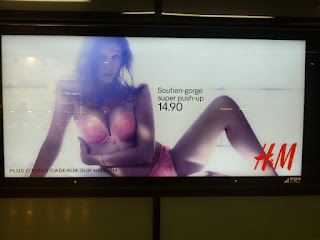When I arrived in Geneva, the city was suffused by an unavoidable ad campaign a line of Super Push Up lingerie available at H&M.
Imagine Victoria's Secret ads at almost every corner bus stop. Nothing outrageously scandalous, just more models in their skivvies.
But There was something especially arresting about the images. Something that felt more affecting than what was evident. Now, that I was projecting something onto these ads is a certain possibility, .
The just slightly larger than life, yet close enough to life -size to create the plausible illusion of passing an actual woman sitting in a window, was this part of it?
The small Calvinist part of my brain chirped up a portent of my own scandalizing if exposed too much to these images.
Ubiquitous were these ads; Bern was similarly peppered with the images.
 |
| In Bern |
I wish I had taken video of the video versions of the ads. In these versions, (about 5 or 10 seconds long), the models in their now familiar poses, their faces in profile, slowly turn their heads to meet your gaze with one of their own, both suggestive and insinuating.
 |
| The video versions. |
Unsettlingly thrilling, intimidating and reminiscent of every self conscious moment of prolonged eye contact with any attractive female in a bar, traffic light, waiting room or checkout line. Talk about breaking the fourth wall. These videos, elicit that same instinctive internal voice: "Me? Is she looking at Me?" The ads ran their course and were off the monitor cycle before I could reach the "Yeah. She's checking me out." point.
So on my way to meet Andre Dussoix in his Chatelaine home, I encountered string of these ads, three or four, all on his street, but these versions had the distinction of being touch by modesty.
This intervention had a potency of emotion and intent which I could feel right away. This was no jokey act of defacement. This expressive use of a roller and white paint made a statement.
The gesture was jarring, a kind of repudiation of the media infused environment we pass through constantly. A rebuke of not just boobs an bums, but of the grip of our commercial overlords.
What was it about this particular stretch of suburbia that repelled not just these ads? My first thought was that it had to do with the fact that a school was located on the block. High school age students passing me as I mulled over these images on my way to Andre's house. I decided against any direct relation to the presence of the school. This was a universal statement. My mind moved to conjuring up a band of conservative Muslim taggers. That band winnowed itself down to a lone tagger, paint tray and roller in hand and a great mission in mind.
On yet another trip to the Dussoix household, Xavier confirmed my suspiscion with his own sense that the defacement (debodiment?) was related to the influx of Muslim immigrants to the neighborhood.
This brought to mind the nature in which places change through migration, not just through the slow evolutionary process of an amassing demographic, but through the way that group seeks to project its values onto the existing culture of a place. In the States, this process is generally seen to move in a conservative to liberal direction. This is an alternate process at work. Perhaps piefication?
A segment of a PBS show on the history of visual depictions of Jesus Christ which we were watching just before Christmas touched on the use of white wash as a tool of Protestant driven iconoclasm in the middle ages. This action on those Chatelaine billboards was indeed a classic form of iconoclasm being brought to bear on the sultry pillars of this secular world's most effective iconocraphy. This bit of historical information added a whole other layer of significance in my consideration of what I had seen at work on these adverts.
In any case, that recessed Calvinist inside me voiced a relieved thanks that I might be spared this additional little bit of demoralization.
 |
| My own riff on the subject, done while in Geneva, gouache, pencil, and pastel on paper. |











No comments:
Post a Comment